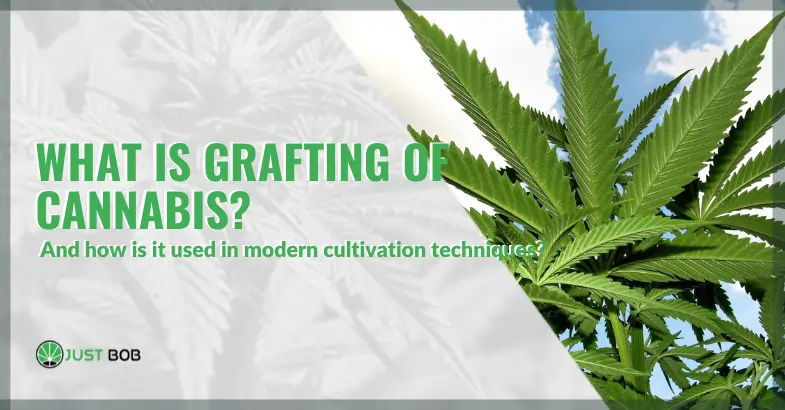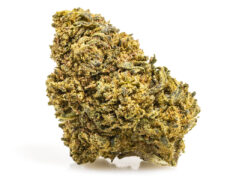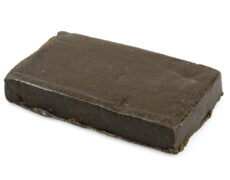Published on: 08/10/2025
Fusing genetics to create horticultural marvels
Welcome to the fascinating world of cannabis cultivation, a realm where ancient horticultural arts meet cutting-edge botanical science. Today, in this JustBob‘s article, we’re delving into a technique that sounds like something out of a science fiction novel but is, in fact, a practice thousands of years old: grafting.
Imagine a single plant capable of producing several different varieties of cannabis, each with its unique profile. This isn’t magic; it’s the art of grafting, a method that allows growers to physically join two or more plants so they grow as one singular, cohesive organism.
This advanced technique is more than just a novelty; it represents a sophisticated approach to cultivation, offering solutions for saving space, preserving precious genetics, and even enhancing a plant’s natural resilience.
For the discerning collector or the passionate home grower, understanding grafting opens up a new dimension of appreciation for the plant’s versatility. It’s a testament to the sheer ingenuity that defines modern cannabis culture.
While cloning creates exact genetic copies, grafting allows for a creative fusion of traits, merging a robust root system (the rootstock) with the desirable top part of another plant (the scion).
This technique is gaining traction among experts looking to push the boundaries of what’s possible, creating living sculptures that are as fascinating to observe as they are complex.
It’s an intricate dance of biology and skill, much like the careful process of curating and preserving the aromatic profiles of high-quality light cannabis flowers for collection purposes.
Read also: The different methods to cultivate cannabis
A Brief History of Grafting: An Ancient Technique Meets Modern Cannabis
Grafting isn’t a recent invention; its roots stretch back thousands of years, with records suggesting its use in ancient China and Mesopotamia. Early agriculturists likely observed natural grafting, where two plants growing close together fused on their own, and ingeniously decided to replicate the process.
This horticultural art was perfected over centuries, particularly with fruit trees and grapevines, to propagate desirable varieties and combat diseases.
For example, much of Europe’s wine industry was saved in the 19th century by grafting European vines onto disease-resistant American rootstocks. It stands as one of humanity’s earliest forays into modifying plants to our advantage, long before the age of genetic engineering.
This age-old practice has found a new and exciting application in the world of cannabis. While it has been overlooked by many in the community, pioneering growers are now adapting these ancient methods to modern cultivation.
The principles remain the same: joining a scion to a rootstock to benefit from the best traits of both. The application to cannabis, however, is particularly intriguing.
It addresses modern challenges like space limitations in grow rooms and legal plant count restrictions. For those who appreciate the vast genetic library of cannabis, from landrace strains to modern hybrids, grafting offers a way to maintain a diverse collection on a single plant.
It is a beautiful parallel to how a connoisseur might collect different varieties of CBD hash, each valued for its unique texture, aroma, and origin, preserving a wide spectrum of characteristics in a compact form. This technique is truly a bridge between horticultural history and the future of cannabis cultivation.
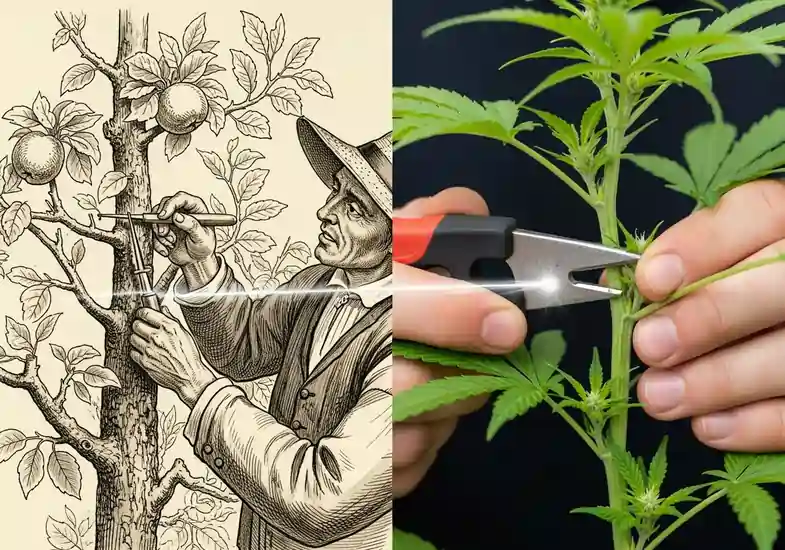

The Science Behind the Bond: How Cannabis Grafting Actually Works
At its heart, grafting is a remarkable biological feat that relies on a plant’s natural healing ability. The success of a graft hinges on the precise connection of the vascular tissues of the rootstock and the scion, specifically the cambium layer.
This thin layer of actively dividing cells is responsible for secondary growth and the transportation of water and nutrients. When the cambium layers of the two separate plants are aligned and held firmly together, they begin to heal and fuse.
The cells intermingle, forming new vascular connections—xylem and phloem—that allow the scion to draw water and nutrients from the rootstock’s established root system.
Essentially, the scion becomes a new, living part of the host plant, continuing its growth as if it were still attached to its original roots. For this fusion to be successful, a few conditions are crucial.
Firstly, the plants must be genetically compatible; fortunately, all cannabis cultivars come from the same plant family, making them compatible with one another.
Secondly, the cuts must be clean and precise to maximise the surface area where the cambium layers meet.
Finally, the graft union must be kept secure, moist, and free from pathogens during the critical healing period, which typically takes around one to two weeks.
Understanding this intricate process elevates the appreciation for the skill involved. It’s a delicate operation, requiring a steady hand and a clean environment—not unlike the meticulous extraction processes used to create pure CBD oil, where precision is paramount to achieving a high-quality final product for technical or cosmetic use.
This surgical precision is what makes grafting both a challenge and a marvel of botanical science.
The ‘Franken-Plant’ Myth: Unpacking the Benefits of Grafting Cannabis
The image of a single plant bearing multiple different strains might conjure up ideas of a “Franken-plant,” but the reality is far more elegant and practical. Grafting is not about creating a monstrous hybrid; it’s about strategic cultivation with a host of tangible benefits. Perhaps the most celebrated advantage is the ability to grow several different strains on one mother plant.
This is a game-changer for growers facing space constraints or legal limits on the number of plants they can cultivate.
Instead of choosing just one variety, a grower can enjoy a diverse garden on a single root system, sampling different aromas, structures, and characteristics all at once.
Beyond space-saving, grafting is an exceptional tool for preserving genetics. Imagine you have a prized cultivar but limited room to keep a mother plant for clones; you can simply graft a branch onto another plant.
It’s also a powerful method for improving plant performance. A strain with incredible flowers but a weak root system can be grafted onto a vigorous, disease-resistant rootstock, enhancing its overall health and potential yield.
This can also be used to rescue a damaged plant or to test a new, unproven strain without committing to growing it from seed to harvest. The aesthetic appeal is undeniable, too; a multi-strain plant is a living piece of art, a unique specimen for any serious collector.
This dedication to preserving and showcasing diversity mirrors the passion behind collecting rare light cannabis strains, where each bud is appreciated for its distinct terpene profile and visual beauty, intended for decorative purposes or as a source of rich aromatherapy.
Grafting transforms a simple plant into a curated collection, showcasing the incredible diversity of the cannabis genus.
Tools of the Trade: What You Need to Get Started with Grafting
Embarking on your grafting journey doesn’t require a high-tech laboratory, but it does demand precision, cleanliness, and the right set of tools. Having everything prepared before you begin is crucial, as the process needs to be done quickly to prevent the cut surfaces from drying out.
The most essential item is an extremely sharp, sterile blade. A scalpel or a fresh razor blade is ideal for making the clean, precise cuts necessary for a successful fusion. Alongside your blade, you’ll need a pair of clean gardening shears to trim branches and foliage.
To secure the graft, you will need grafting tape. Plumber’s or paraffin tape works well as it’s sterile, malleable, and creates a perfect seal to block out light and air while the union heals.
Some growers also use gardening wire or grafting clips for extra support.
To maintain humidity around the new graft, which is vital for the first few days, small plastic bags (like zip-lock bags) can be used to create a mini-greenhouse over the scion. A spray bottle filled with a light vegetative nutrient solution at the correct pH is also helpful for keeping the cut surfaces moist during the procedure.
A clean and organised workspace, including a cutting board, is non-negotiable to prevent contamination.
The meticulous preparation and attention to detail are reminiscent of the care taken in crafting premium products like CBD-infused cosmetics, where every ingredient and step is carefully controlled to ensure purity and quality for the end-user.
Mastering these tools is the first step towards mastering the art of grafting.
Step-by-Step: A Look at Common Cannabis Grafting Techniques
While there are several grafting methods, a few are particularly well-suited for cannabis due to the plant’s structure. One of the most common and straightforward techniques is the Whip Graft, or Splice Graft.
This method is ideal when the rootstock and the scion are of a similar diameter. It involves making a long, sloping diagonal cut on both the scion and the rootstock branch.
The two cut surfaces are then perfectly aligned, ensuring maximum contact between the cambium layers, and firmly wrapped with grafting tape. The key is to make the cuts as identical as possible and to work quickly to prevent the exposed tissues from oxidising.
Another popular method is the Cleft Graft, which is useful when the rootstock is thicker than the scion. In this technique, a vertical split is carefully made down the centre of the rootstock branch.
The base of the scion is then carved into a V-shaped wedge that fits snugly into the cleft. Once inserted, the graft is sealed and wrapped just like the whip graft. This method can even accommodate two smaller scions into one larger rootstock branch.
For all techniques, the aftercare is just as important as the procedure itself. The new graft needs high humidity for the first week or two, often achieved by placing a plastic bag over it, and the plant should be kept under 24-hour light to encourage healing and prevent the scion from wilting.
This period of careful nurturing is crucial, demanding patience and observation, much like the slow curing process required to develop the full aromatic bouquet of a collectable hashish CBD piece, where time and care unlock its true character.
Success lies in both the cut and the subsequent care.
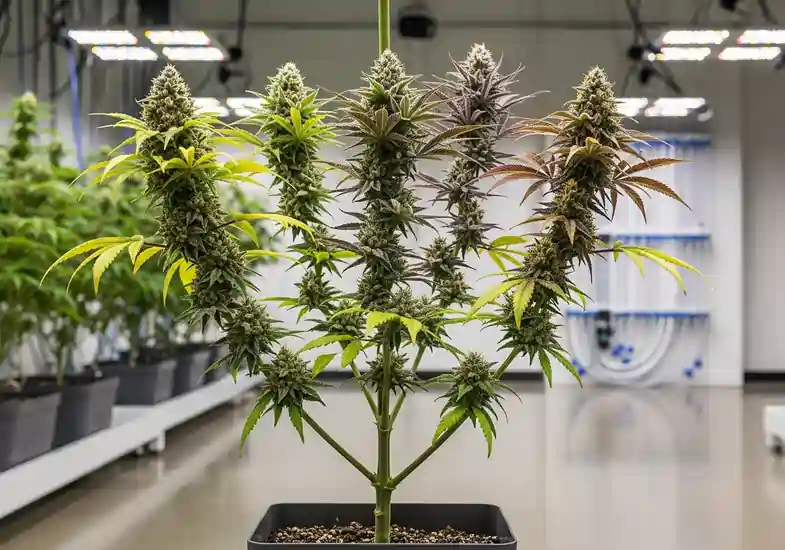

Beyond the Grow Room: Grafting’s Impact on Cannabis Research and Variety
The implications of cannabis grafting extend far beyond the hobbyist’s grow room, offering profound possibilities for scientific research and commercial cultivation. For researchers, grafting is a powerful tool to study plant physiology.
It allows them to investigate the complex communication between the root system (rootstock) and the shoot (scion). Recent studies have shown that grafting can influence root health, increase biomass, and even cause slight changes in the cannabinoid profile of the scion, suggesting that the rootstock can chemically signal and affect the development of the grafted part.
This opens up new avenues for understanding how cannabinoids and terpenes are produced and how they can be optimised.
In the commercial sphere, grafting could be used to enhance crop performance.
High-yielding but finicky strains could be grafted onto robust, disease-resistant rootstocks, creating more resilient and productive plants tailored for specific environments. This technique could standardise production and solve issues like poor rooting in certain valuable cultivars.
Furthermore, for breeders, grafting offers a way to keep a ‘library’ of genetic material on a single mother plant, saving immense space and resources while pheno-hunting or making crosses.
The potential for creating bespoke plants is immense. One can imagine a future where cultivators offer custom-grafted plants, combining different light cannabis varieties known for their unique aromatic profiles for the ultimate collector’s item.
This level of customisation reflects a sophisticated market, one that appreciates the nuanced qualities of products like broad-spectrum CBD oil, where specific cannabinoid and terpene profiles are preserved for their synergistic potential in aromatherapy applications.
Grafting is not just a technique; it’s a platform for future innovation.
Read also: Organic cultivation & Cannabis: the benefits – JustBob
Conclusion: The Art and Science of Cannabis Grafting
Grafting cannabis is where ancient horticultural wisdom meets modern botanical ambition. It is a technique that transcends simple cultivation, elevating it to an art form that requires skill, patience, and a deep understanding of the plant’s biology.
From its historical roots in agriculture to its current application in advanced cannabis cultivation, grafting offers a remarkable set of benefits.
More than just a novelty, grafting is a strategic tool that can enhance a plant’s vigour, resilience, and even its yield by combining the strengths of different cultivars.
For the enthusiast, it offers a new level of engagement with the plant, a way to create a truly unique living specimen. This sophisticated appreciation mirrors the way connoisseurs approach other fine cannabis products, and it’s essential to understand the legal framework surrounding them.
In many European countries, the sale of CBD flowers and similar items is not intended for consumption. Instead, these products are offered by CBD online shop exclusively for a variety of other purposes, which include technical use, decoration, academic research, and, most notably, collecting and aromatherapy.
They are valued as botanical specimens for their genetic purity and complex aromatic profiles. This mindful and lawful approach to collection deepens one’s connection to the plant in a responsible manner.
It reminds us that there are always new layers to explore—from groundbreaking cultivation techniques like grafting to the intricate legal landscapes that shape our interaction with this versatile species—and that the potential for innovation in the world of cannabis is virtually limitless.
Grafting of cannabis: Takeaways
- Grafting is not a recent innovation but a time-honoured horticultural method now being skilfully applied to cannabis. By joining multiple varieties onto a single plant, growers can blend genetic traits while conserving space and staying within legal plant limits. This technique is particularly beneficial for collectors and enthusiasts aiming to preserve diverse genetics in a compact, efficient way.
- The success of grafting depends on the perfect alignment of vascular tissues, especially the cambium layer. Clean, sterile cuts and a carefully managed healing environment are essential for the graft to take. When done correctly, the scion becomes an integrated, living part of the host plant, benefiting from a stronger root system. This process, both scientific and artisanal, showcases the high level of skill involved in advanced cannabis cultivation.
- Beyond hobbyist use, grafting holds remarkable potential for scientific study and large-scale production. Researchers use it to explore plant communication and development, while commercial growers can enhance yield, disease resistance, and consistency by pairing finicky strains with vigorous rootstocks. For breeders, it’s a practical way to maintain a living library of genetics. Grafting is more than a technique—it’s a strategic platform for future innovation in the cannabis industry.
Grafting of cannabis: FAQ
What is cannabis grafting and how does it work?
Cannabis grafting is a horticultural technique where two different cannabis plants are physically joined to grow as one. The root system (rootstock) supports the upper part (scion) of another plant. For a graft to succeed, the vascular tissues, especially the cambium layers, must align precisely. This fusion allows water and nutrients to flow between the two plants, enabling the scion to thrive on the rootstock. Grafting is commonly used to combine desirable traits such as resilience and flower quality. It’s a delicate but powerful method requiring cleanliness, precision, and proper aftercare to ensure a successful bond.
What are the benefits of grafting cannabis plants?
Grafting cannabis plants offers multiple advantages for both hobbyists and commercial growers. It allows different strains to grow on a single plant, saving space and complying with legal plant count limits. It also helps preserve rare genetics by maintaining cultivars on a shared rootstock. Grafting improves plant performance by combining strong roots with premium flowering traits. Additionally, it enables the recovery of damaged plants and the testing of new strains. Aesthetically, multi-strain plants become living works of art. Overall, grafting enhances cultivation flexibility, efficiency, and diversity.
Can grafting impact the cannabinoid or terpene profiles of cannabis?
Yes, grafting can subtly influence the chemical profile of cannabis plants. While the scion generally retains its original cannabinoid and terpene profile, the rootstock can affect growth vigor and nutrient uptake, which may slightly alter the plant’s overall chemical expression. Researchers have begun exploring how rootstock traits influence the scion’s development, opening doors to optimizing cannabis characteristics through grafting. This technique also helps study root-to-shoot signaling, contributing to our understanding of how cannabinoids and terpenes form. It’s a fascinating intersection of traditional horticulture and modern cannabis research.

